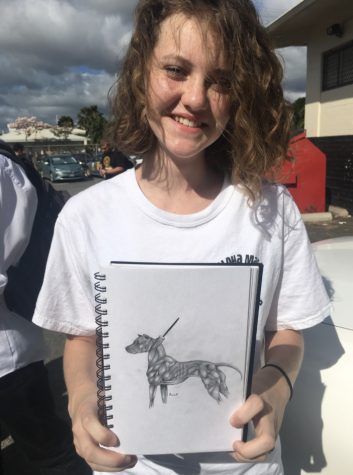Dog Lover Educates General Public on Pit Bulls
March 16, 2018
American Pit Bull Terriers, or as most people like to call them, pit bulls, are infamous for being aggressive fight dogs. In an attempt to educate people on the breed, Ilana Borgesen (10) has become an expert on the dog breed. She has been learning about the breed for about two years.
American Pit Bull Terrier is a canine breed reaching all the back to early 1900s and late 1800s that originated from the original bulldog, used to fight bulls for sport.
“As the terrier was bred into the dog, it was known as the bull and terrier bred for specifically dog fighting, and was then called the American Pit Bull Terrier,” Borgesen said.
A common stereotype about the APBT breed is that trainers can change their aggressiveness, depending on how they are raised or their group of breeds. APBT was bred for dogfighting, meaning they have genetic animal and dog aggression along with a high prey drive.
“They will always possess these qualities or else they’re not true to the breed. However, they should never be human aggressive,” Borgesen said. “On the contrary, the pit bull being a group of breeds is also a myth. Pit bull is short for American pit bull terrier, the only breed with pit bull in the name.”
Like, lab is short for labrador retriever and Aussie is short for Australian shepherd, there is no pit bull type of dog.
Some people say that depending on how the dog is raised and the level it is given, it will change its aggression. It’s 90 percent genetics and 10 percent environment.
“Retrievers will retrieve, pointers will point, terriers will dig and be drawn towards small animals,” she said.
This means the real pit bull will always retain animal and dog aggression. But, dogs can be trained to be obedient to commands such as responding when saying its name, telling it to stay, down, sit, and teaching a command to call the dog off. Just because the breed a person wants is described as stubborn or aggressive, it doesn’t mean the person should not train it basic obedience. This will save a dog’s life.
Another common stereotype is that APBT has a stronger bite pressure, or they’ll lock their jaws when they bite. APBT, in reality, has an average bite pressure, but the myth behind lockjaw, which is untrue, is because of a thing called game.
“Game is what determines a dog’s fight or flight stimulus. The APBT has the highest game out of any breed, meaning they will latch on and fight until they die,” Borgesen said.
APBTs are a small breed, but what they lack in size and immense strength like a mastiff or kangal, for example, they make up for in confidence and fight.
While some people don’t let some things like this get in the way of adopting an APBT, Borgesen would like to educate people on what they should do before they attempt adopting one.
“Firstly, you will never find a real pit at a shelter. On that note, before you buy from a reputable, proven breeder, you will need to research the breed intensely.” she said.
They are animal aggressive, high-drive, high-game dogs that can scale a six foot fence and need mental and tons of physical stimulation or they will not fare well.
It is important to research breeders because APBTs are so rarely well-bred nowadays that most breeders are just people breeding two dogs with no proven lineage and calling them pits for quick cash. A true responsible breeder will health test and screen both parents and the pups.
“In most breedings, both parents are also proven and titled by a proven kennel club of the breed, in this case would be UKC and/or ADBA.” Borgesen said.
Many people tend to mix up APBT with many other breeds.
“The only logical way to identify a real pit would be a pedigree.” Borgesen said.
The breed is so misconstrued by the general public and BSL and the fact that the breed comes in many lines and appearances makes it only possible to identify one professionally by pedigree.
“A dog without a pedigree cannot be labeled a Pit Bull. This mislabeling causes death to millions of dogs every day,”she said.
Dog obesity is another problem among dogs, not just APBT. Obesity in dogs is much more damaging than starvation. A starving dog will die if left to starve, but there will not be long term effects.
“You can feed and tend to a starved dog and the pup will get better in time,” she said. “Obesity in dogs, on the other hand, will result in lifelong damage such as deformed growth plates if started from puppyhood, joint problems, pressure on the spine, and exercise deficiency. These cannot be reversed, however they can be improved.”
Borgesen would like people to know that the reason why bite statistics are so inflated for the breed is because people lump any short haired dog into the pit bull category when in reality, they are mutts.
Pit bull is a breed, and not a group of dogs. They require experienced, knowledgeable owners who are open minded and mentally and physically strong. Most importantly, they will be aggressive. But, they are intelligent and highly driven. Exercise is needed for them to function properly. People need to understand that this dog may not be for everyone, but that is okay.


